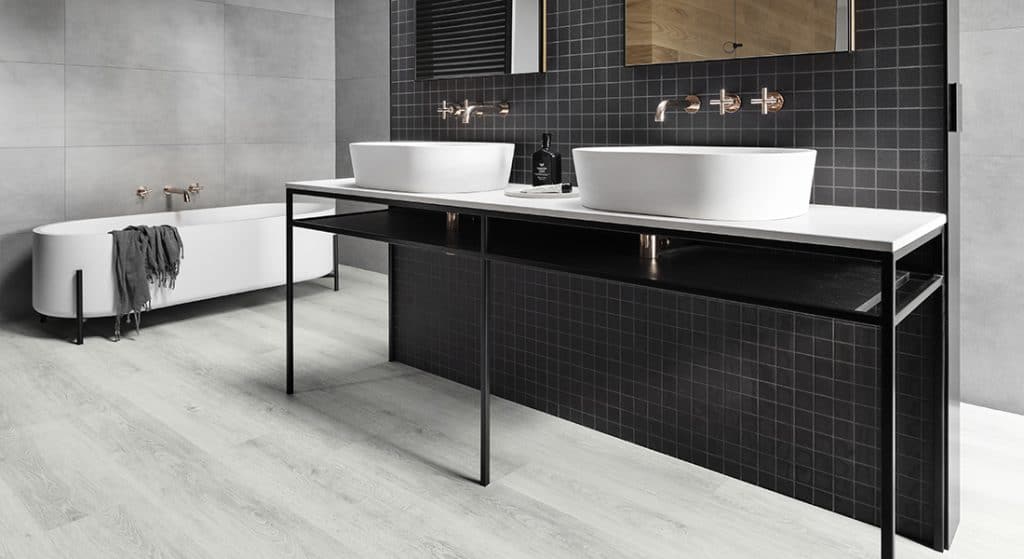Imagine this: you’re finally ready to embark on your dream bathroom renovation. You’ve meticulously selected the perfect vanity, a statement piece that reflects your style and enhances the space. But a crucial question arises: can you install this beautiful vanity on your existing vinyl plank flooring? This is a question many homeowners grapple with, and the answer, as you might expect, isn’t always straightforward.

Image: www.seanandann.org
Vinyl plank flooring, with its durability, affordability, and stylish appearances, has become a popular choice for bathrooms. However, its nature presents unique considerations when it comes to supporting heavy furniture like vanities. This article will delve into the intricacies of installing a vanity on vinyl plank flooring, exploring the factors to consider, potential challenges, and expert advice to ensure a successful and safe setup.
Understanding the Challenges
Vinyl plank flooring, despite its resilience, can pose certain challenges when supporting a vanity. Unlike solid hardwood floors, vinyl planks are relatively thin and may lack the inherent strength to withstand substantial weight distribution. Here are some key considerations:
1. Weight Distribution and Structural Integrity
Vanities, especially those with large cabinets and drawers, can exert significant pressure on the flooring. Vinyl planks are not designed to handle such immense weight over extended periods, potentially causing them to buckle, sag, or even crack.
2. Moisture Sensitivity
Bathrooms are inherently humid environments. While vinyl plank flooring offers some resistance to moisture, prolonged exposure can weaken the material, affecting its structural integrity. This vulnerability becomes more pronounced when supporting the weight of a vanity, creating an increased risk of damage or premature degradation.

Image: www.signaturefloors.com.au
3. Subfloor Considerations
The effectiveness of vinyl plank flooring supporting a vanity largely depends on the quality and strength of the underlying subfloor. A weak or uneven subfloor can transfer the weight of the vanity unevenly to the vinyl planks, leading to potential problems.
Solutions and Best Practices
While the challenges are real, they are not insurmountable. Several solutions and best practices can mitigate the risks associated with placing a vanity on vinyl plank flooring. These can help ensure a sturdy and long-lasting setup.
1. Assessing Your Subfloor
Before proceeding with installation, thoroughly assess the condition of your subfloor. Ensure it’s level, free of cracks or significant warping, and adequate in thickness to support the weight of your vanity. Consider consulting a professional if you need an assessment or reinforcement.
2. Reinforcing the Subfloor
If your subfloor is found to be insufficient, reinforcement is crucial. This may involve adding plywood sheets over the existing subfloor, providing greater strength and stability for the vinyl plank flooring. The added layer distributes the weight of the vanity more effectively.
3. Using a Sturdy Vanity Base
Choose a vanity with a sturdy base made from solid materials like wood or metal. Avoid vanities with flimsy or weak bases as they are more likely to cause problems on vinyl plank flooring.
4. Footpad Protection
Employ protective footpads or furniture sliders underneath the base of your vanity. These distribute the weight more evenly and protect the vinyl planks from scratches and pressure points. Look for pads designed for heavy furniture and consider using multiple pads for optimal support.
5. Professional Installation
To minimize the risk and ensure proper installation, consider hiring a professional contractor experienced in bathroom renovations and flooring installations. Their expertise can help address any specific challenges related to your particular flooring type and vanity setup.
Alternatives to Consider
If the risks associated with placing a vanity on your existing vinyl plank flooring seem too high, or if you prefer an alternative solution, consider exploring these options:
1. Replacing the Flooring
A more permanent solution is to replace your existing vinyl plank flooring with a material better suited for supporting heavy furniture. Solid hardwood floors or ceramic tiles offer greater strength and stability for vanities, even in humid bathroom environments.
2. Installing a Pedestal Sink
Pedestal sinks offer an elegant alternative, eliminating the need for a large cabinet. They are often more lightweight and require less support, making them a good choice for vinyl plank flooring. They are also generally less expensive than traditional vanities.
3. Wall-Mounted Vanity
Another space-saving and practical choice is a wall-mounted vanity. These vanities are suspended from the wall and do not rely on the flooring for support. They provide a streamlined look, are easier to clean, and can be particularly advantageous for smaller bathrooms.
Can You Set A Vanity On Vinyl Plank Flooring
Conclusion
Installing a vanity on vinyl plank flooring requires careful consideration and planning. While challenges exist, solutions and best practices can ensure a safe and successful setup. The importance of assessing your subfloor, reinforcement techniques, sturdy vanity choices, protective footpads, and professional installation cannot be overstated. Ultimately, weigh the pros and cons, explore alternatives, and make informed decisions based on the specific characteristics of your bathroom and the weight of your vanity. With thoughtful planning and execution, you can enjoy your beautiful new vanity while preserving the integrity of your flooring.





